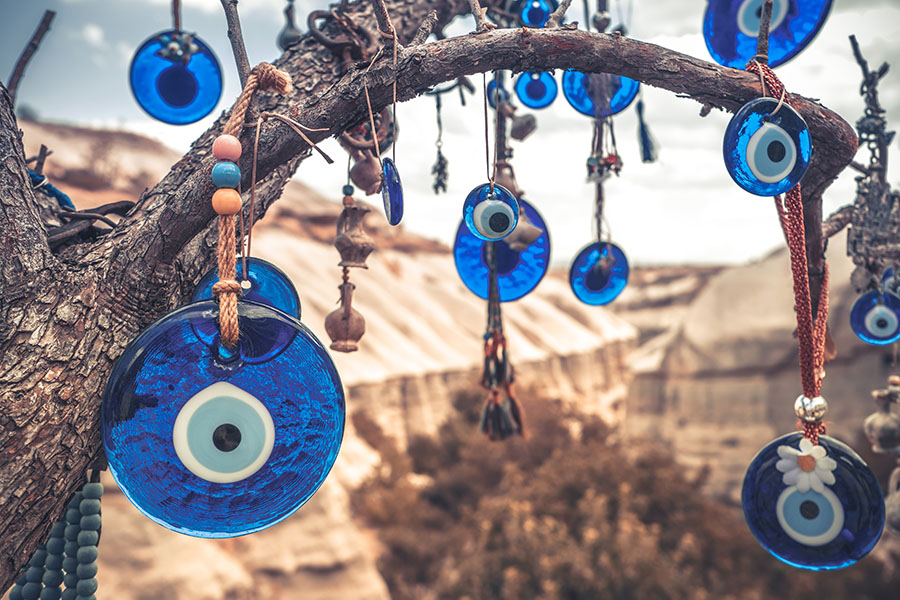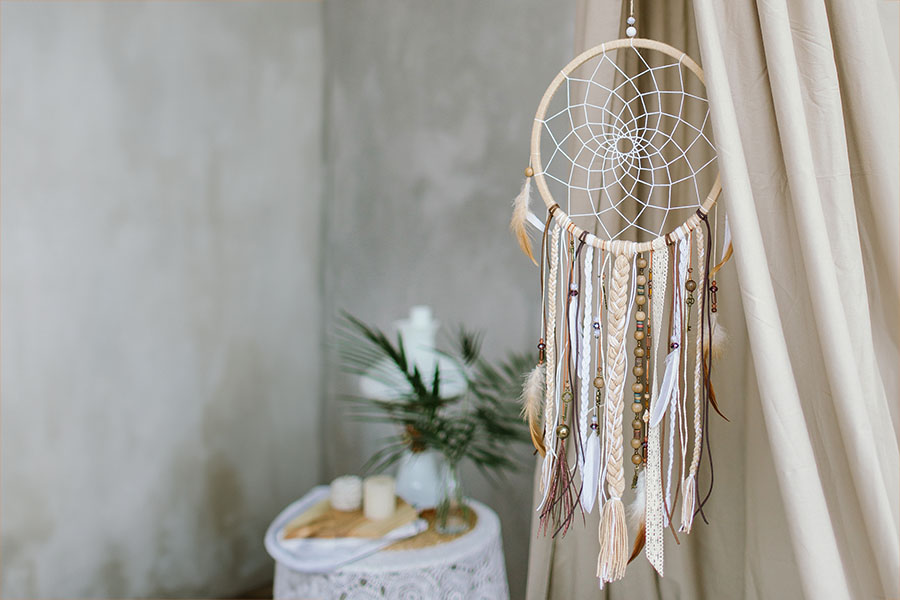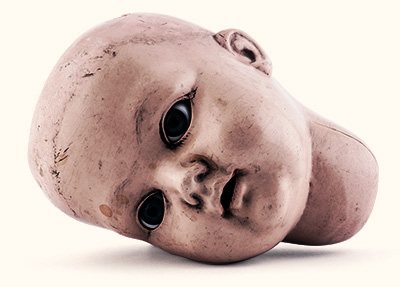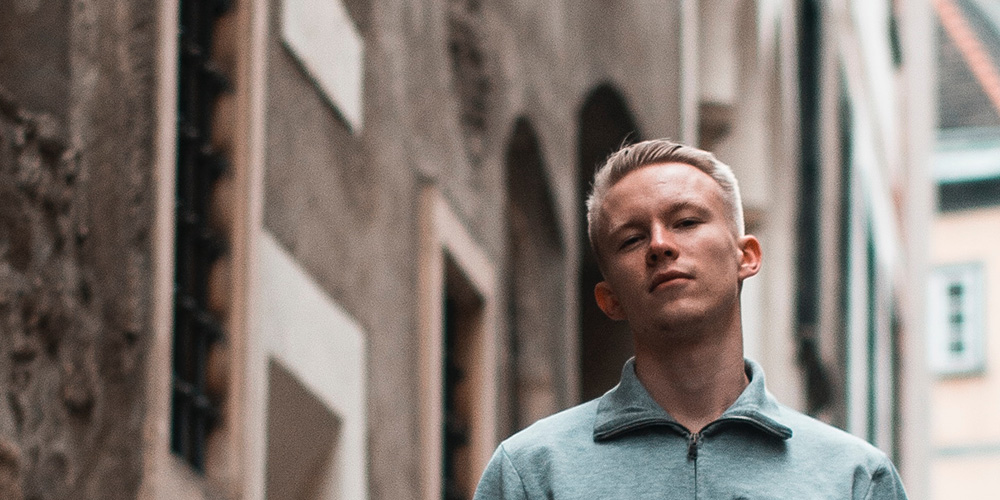The idea of protecting one’s home against evil spirits and energies is an age-old practice in many cultures. Becky once told a story about the family member who attempted to ward her first born baby against the evil eye without her consent. But what is the Evil Eye? What are wards? Where does a ward get it’s power from? How do you use a ward? We’ve learned a lot from the guests on Homespun Haints about the origins, significance, and ways to utilize supernatural wards to safeguard your home, and avoid the influence of the Evil Eye.
Understanding the Evil Eye: Origins and Beliefs
The concept of the Evil Eye is nearly ubiquitously familiar, although it’s especially prevalent in Mediterranean, Middle Eastern, South Asian, and European cultures. This superstition suggests that envious or negative glances cast upon someone can bring that person misfortune, bad luck, or harm. To counteract this, various cultures have developed wards for protection.
A ward can be pretty much anything that you believe has the ability to counteract the presence or happening of something supernatural and potentially harmful or undesirable. In other words, it doesn’t have to be a physical object. For example, to fend off jealous glances, you might practice negative mantras, like “I’m nothing special…I look hideous…nobody loves me…” Yikes, who wants to say that all day? Better perhaps to just wear an amulet.
The Nazar: Warding off the Evil Eye with…another eye?
The Nazar, commonly known as the evil eye, is an amulet or talisman to deflect negative energy. This symbol, often found in jewelry, home decor, and even in architecture, specifically serves as a defense against the evil eye. You’ve seen it: a circular, blue-and-white eye-shaped symbol. It’s supposed to absorb malevolent glances and prevent them from causing harm.

Hamsa Hand: Specifically about the number five.
The word “Hamsa” (or Khamsa) comes from the Arabic word for “five.” The significance of this symbol is not just the fact that it is a hand, but that the hand specifically has five fingers, all aligned. The Hamsa’s palm usually features an embedded eye, to provide defense against negative energies and misfortune. It’s kind of like a Nazar, but more overarching in its symbolism. The eye represents heightened awareness, insight, and protection from harm. The hand itself signifies blessings, strength, and the ability to push away negative influences.
The Hamsa in different faiths
The Hamsa represents different meanings (and sometimes has different names) across cultures. In Jewish culture, it is the Hand of Miriam, and symbolizes divine protection. For Muslims, it represents the hand of Fatima, daughter of the Prophet Muhammad, and is associated with patience, loyalty, faith, and protection against the evil eye.
Some people use an upside down Hamsa to attract wealth and fortune, and one facing upright to protect against harm. In those instances, the position of the Hamsa represents various mudras, which are basically gestures intended to alter the flow of energy during rituals. This may be more common in Hinduism, Jainism, or Buddhism, or among yoga practitioners. In spiritual healing techniques hailing from these cultures, the five fingers of the hand can represent chakras, or elements. Some new-age energy healers use their hands like multipolar magnets, intending the energy flow direction to alternate in a beneficial way as it flows down one side of a finger and up the next.
Placement and Use
Hamsa or Nazar symbols are placed strategically within the home, usually at entrances or in central areas, to ward against evil. While positioning these symbols, individuals often focus on their intentions to shield their spaces from harm and negativity. The power of the ward comes from the belief or faith of the individual who puts it there, and so we tend to place them in areas we consider vulnerable to infiltration. That’s likely why the front door is a very common location for a Hamsa. It’s also wise to place a Hamsa in an area where you’ll see it frequently; reminding yourself that it’s there and working on your behalf is a great way to continually imbue it with the power of your faith in it.
Maintenance and Upkeep of Protection Wards
You might, from time to time, feel the need to do a little extra Hamsa maintenance. When you’re feeling especially unlucky and downtrodden, a ritual cleansing for your physical wards can renew your intentions with them. You can cleanse and revitalize their protective energies exactly how you’d spiritually cleanse any other object. For example, try smudging with burning sage, incense, or palo santo, exposing the symbols to sunlight, or placing selenite on them.
The Universality of Wards
The popularity of the Hamsa and Nazar reveal the universal human desire to safeguard against negative energies and spirits. They serve not only as protective amulets, but also as sources of comfort, strength, and a reminder of the power of energy—both positive and negative—within our homes and lives.
People all over the world use symbolic wards. The Hamsa is one of the most widespread wards against evil globally. However, here are a few examples of wards from other cultures that share some characteristics with these hand-and-eye symbols.
The Eye of Horus (Wadjet) – Egyptian Tradition
The (usually left) Eye of Horus symbolizes protection, health, and royal power. The Wadjet provides safety, health, and prosperity. According to ancient Egyptian texts, the falcon god’s eyes were ripped out by the god Seth and then restored. Horus’s eye has served as a talisman against evil ever since. Even though the Hamsa, Nazar, and Eye of Horus all prominently feature an eye, it’s more because humans tend to ascribe mystical properties to the eye as a symbol, rather than implying a shared origin.
Crosses and Crucifixes – Christianity
Crosses and crucifixes represent faith and salvation for Christians, which is somewhat equivalent to protection from evil. Christianity sometimes equates protection from evil with submission to the divine plan. The crucifix often depicts Christ’s eyes upturned towards heaven, some say symbolically of his submission to God’s will. His outstretched hands, marred by wounds, can represent both his sacrifice to protect mankind from evil, and his message of being open, accepting, and loving towards others.
Christ’s hands, like Hamsa, carry much symbolic protective weight, whether praying, bearing stigmata, or laying on healing, but the meaning is more associated with the cross itself than Christ’s hands. So much has the cross become a protective ward in the Western world that, according to most vampire lore, crosses are objectively reliable protection from these avatars of supernatural evil, even if the bearer is not a Christian. Christians often wear crosses as jewelry for personal protection, or place them in homes to invoke divine protection and ward off evil spirits.
Dreamcatchers – Native American Tradition
Dreamcatchers are woven, weblike, 3D wards. Their use as a printed symbol is rarer, as they’re intended to act kind of like a spiritual colander, and it’s the passing through from one side to another that makes them work. Dreamcatchers filter out negative dreams and spirits, allowing only positive dreams to pass through. They function as wards to protect a home or its dreaming inhabitants during sleep. Dreamcatchers are often wildcrafted from natural materials.

Hagstones – Celtic and European Tradition
Also found in nature, hagstones are a symbol of good luck and protection in Celtic traditions. Basically any natural stone with a hole worn all the way through it counts as a hagstone. Hanging a hagstone outside your door or in your home can also ward against evil spirits.

Yantras – Hinduism and Buddhism
Yantras are sacred geometric symbols. In traditions like Hinduism, various versions of yantras can ward a home from evil. In Buddhism, yantras are more commonly referred to as mandalas. Their geometric patterns are intended to resonate with different energetic frequencies. By meditating on these yantras, practitioners can tap into these energies, fostering a connection with the divine and amplifying the yantra’s protective qualities. Each design corresponds to different aspects of the divine and is associated with specific deities, enhancing its effectiveness in guarding against malevolent forces.
Runes – Norse and Germanic Traditions
Norse and Germanic cultures used runic symbols for protection and divination. Each rune carries its own meaning and protective qualities. Carrying or inscribing certain runes can offer defense against evil and negative forces. According to one archived resource, some common runes for warding against evil include the following.
- Algiz (ᛉ): The “protection” rune, Algiz, represents defense, protection, and warding off danger. Interestingly, Algiz often resembles an open hand with splayed fingers, similar to Hamsa. It’s often used to create a protective shield around one’s home or self.
- Othala (ᛟ): Othala symbolizes safety of personal property.
- Eihwaz (ᛇ): Eihwaz is associated with endurance, resilience, and the ability to overcome challenges. It can symbolize the physical form of a strong, trustworthy protector.
These runes are inscribed on talismans, amulets, or protective charms and placed in strategic locations around the home to enhance their protective qualities.
Do you use wards?
The widespread use of these protective symbols as wards highlights the universal human desire for protection from evil. While this need is universal for obvious reasons, it is curious that the symbolism of the eye and the hand transcends so many cultural boundaries to carry similar meaning as a ward against evil. Perhaps these symbols’ ubiquity implies that, regardless of the physical focus we use, the power to ward was within our innate human form all along.
If you’ve got a story to tell about wards, please submit to tell it on our podcast!







